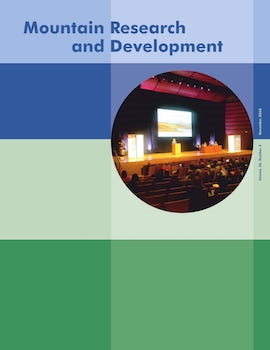Nepal: An Introduction to the Natural History, Ecology and Human Environment in the Himalayas, edited by Georg Miehe, Colin A. Pendry, and Ram Chaudhary. Edinburgh, United Kingdom: Royal Botanic Garden Edinburgh, 2015. viii + 560 pp. £ 70.00. ISBN 978-1-910877-02-9.
The Himalayas have a special status on the planet, not only because they include its highest peaks, but also because of their profound influence on global weather systems, their culture, and their remarkable biodiversity. Nepal is at the center of the Himalayan arc and is the focus of this monograph, which presents a definitive account of the country. It is a companion volume to the Flora of Nepal, which is available as an online resource ( www.floraofnepal.org). The Himalayas are also the scene for one of the most contested debates in recent decades in relation to environment and development. The “theory of environmental degradation” prevailing in the 1970s and 1980s asserted that environmental collapse in the Himalayas was imminent, because of pressures on natural resources from a rapidly growing and increasingly poor population that were leading to forest degradation, massive erosion, and consequent flooding in the Ganges and Brahmaputra lowlands. Subsequent research has led to a more balanced appraisal of the linkages between human activity and the dynamics of change, but a lack of understanding of complex mountainous dynamics influenced the development policy agenda for many years and highlighted the need for real scientific understanding of these fragile environments for sustainable development.
The editors of this tome, with 45 other authors, have drawn on over 40 years of direct experience to bring together the best available information on geology, geomorphology, hydrology, climate, soils, evolutionary biology, ecology, palynology, ethnobotany, anthropology, and conservation. Georg Miehe is professor of biogeography and mountain ecology at Philipps-Universität Marburg and has made annual field visits to the Himalayas since 1976, covering terrain from the north of Pakistan to Nepal, Bhutan, northwest Myanmar, Yunnan, and the Tibetan Plateau, studying plant distributions, vegetation communities, and ecology. Colin Pendry of the Royal Botanic Garden Edinburgh has worked as a taxonomist for the last 20 years, specializing in the flora of Nepal since 2004. Ram Chaudhary is professor of botany at Tribhuvan University, Nepal, and has studied the Himalayas since 1978, covering diverse subjects from floristics and conservation biology through to climate change and livelihoods. Their broad, encompassing experience is reflected in the compendium's content.
The first 7 chapters consider the physical environment. Chapter 1, on the regional setting, discusses Nepal in relation to its surrounding regions and introduces its major climatic and geographic divisions. Chapter 2 comprises the diversity of landscape forms in the region, from the plains of the Terai through the Middle Hills to the alpine regions. Nepal's ecology and tectonic history is covered in Chapter 3. Chapter 4 contains a very detailed description of climate and weather and presents the known and expected effects of climate change. Rivers, lakes, and glaciers, and the significance of Nepalese and, more widely, Himalayan hydrology—“the water towers of Asia”—are discussed in Chapter 5. Chapter 6 links Himalayan landforms and processes, including connections between slope stability and plant speciation. The main soil types of Nepal, and their properties and spatial distribution, are described in Chapter 7. The final section of this chapter discusses soil degradation, drawing on some of the most recent research, and makes the link between soil fertility and livestock manures.
Chapters 8 to 10 consider the flora and fauna, but also introduce the history of botanical exploration and exploitation in Nepal. The description of the fauna focuses on a range of organisms, illustrating their origin, evolution, and zoogeographic connections that have led to contemporary biodiversity. Chapter 11 discusses the diversity of ethnicities in Nepal. Like other mountainous locations with remote and isolated communities, Nepal has considerable ethnolinguistic diversity. The monarchy of Nepal was abolished in 2008, which may bring about changes after centuries of domination by Hindi high castes; but although there have been indications of change, it is still too early to say. Traditional medicinal systems and ethnobotany, related to the country's ethnicity and indigenous knowledge, are the subject of Chapter 12. Nepal has a predominantly rural population, so it is unsurprising that indigenous plants contribute to the subsistence of the majority of Nepalese people. Future research must consider the sustainability of harvesting from the wild in relation to the sustainability of rural communities. Chapter 13 looks at the interconnectedness of land use with agriculture, forestry, and pastoralism in each of the nation's physiographic regions, and discusses geopolitical events and land use even in the most remote regions. Chapters 14 to 16 are integrating; they consider the environmental history of Nepal over time and the effects of global climate fluctuations and increasing human population. The vegetation in 3 regions is described in terms of primary ecological factors and anthropogenic impacts on the landscapes, and vegetation patterns are linked to climatic and soil data, human impacts, and their phytogeographic connections. Chapter 17, finally, looks at the history of nature conservation in Nepal. The country is often cited as having been at the forefront of conservation efforts and protected area systems, and indeed has some highly impressive programs. But at the same time it faces increasing threats to its natural environment from a growing human population, climate change, illegal trade, and invasive plant species, and obtaining sustainable financing for conservation initiatives is difficult.
This volume presents new data and new perspectives and brings even further clarity to the debates of the last 4 decades in relation to the development and poverty alleviation agenda. It highlights gaps in knowledge and the need for further research. This highly informed and immaculately presented production must be a definitive text for researchers working in Nepal and the Himalayas for some time to come. The writing is accessible and the photographs are stunning throughout. It is said to have been primarily written for a professional audience, but should have much wider appeal to anyone with an interest in Nepal and the Himalayas.





